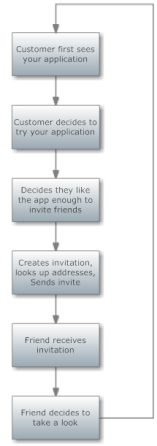
Going Viral: The Science Behind Referrals
September 16, 2020
Sharing. Word of mouth. Going viral. It’s at the core of everything we do here at Sniply. At the end of the day, we strive to make content sharing effective and easy for all marketers and influencers. With sharing at the foundation of our product, you would expect an inherent virality built into our product. Users share our Sniply links, their followers see the awesome service and want it for themselves.
We have certainly seen evidence of this referral process through our organic growth over the past 3 months. But, what I just described is not a truly viral product cycle. Our users create and share thousands of snips every day. While this can certainly increase the awareness of their followers to our product, the process lacks a referral of our services – a vital cog in the viral marketing cycle.
For a better understanding of the viral cycle, I have added a diagram from David Skok’s blog: ForEntrepreneurs (in my opinion one of the best resources for SAAS business strategy on the web).
The third step of the diagram is the crux of the viral marketing business model. Do your users make the conscious decision to share a product or service with friends? The best viral products require inviting your friends for the service to work – the YouTubes, Skypes, Groupons, and other services that require sharing with your friends for the service to work. This required shareability is something that must be built into your product and helps a product go viral. At Sniply, our users need to share our links for the service to add value; but they don’t need to have their friends on the service for the service to add value, so they don’t need to refer friends (although many of you still have and for that we are extremely grateful 🙂 )
Every business wants to experience viral growth – it costs nothing and is incredibly explosive. So how do businesses like ours (with some inherent virality in the product, but not a truly viral product) incentivize their users to refer their friends? The most obvious answer is through a customer referrals program. Let’s look at a few key ways a strong referral program can increase the virality of your business!
Using a referral program to improve your viral marketing strategy
Viral business models use two key metrics – the viral coefficient and the viral cycle time. Optimizing either of these two metrics will dramatically impact the viral growth of your referral program. For the first two examples, I focus on the viral coefficient – a calculation of the number of referrals per user multiplied by the conversion rate on referrals. The higher the viral coefficient, the more shares and conversions, the faster your business grows. For a more thorough explanation, I suggest reading the aforementioned blog: forentrepreneurs (I’ll attach the link at the bottom, so you can finish reading this first 😉 ).
1. A referral program incentivizes users to share with more people
Referral programs provide rewards for sharing, incentivizing users to share this product with friends. That’s the first battle. The use of scaling incentives in a referral program (greater rewards for the more people you share with) will provide a reason for users to invite even more people. This increases the number of referrals per user, and therefore, increasing the viral coefficient.
2. A referral program converts invitees/referees to signed up users
If you have a great product, people are going to tell their friends; but that doesn’t mean that every friend they tell will sign up. By providing incentives to invitees in your referral program, such as discounts or extra features, you can increase the rate at which referees convert into customers. Increasing the rate of conversion increases the viral coefficient.
The second key metric in optimizing your viral business model is the viral cycle time. This is the amount of time it takes for a user to pass through the entire viral cycle. The shorter the viral cycle, the faster users invite their friends, the faster your business grows. Most experts suggest that optimizing the cycle time can have the greatest impact on the virality of your business. When you get into the math behind viral marketing, it’s easy to prove why. But that’s for another post. Bottom line: It doesn’t matter how much you increase the viral coefficient if your cycle time is inefficient. A referral program can help here as well.
3. A referral program can start the process of discovery and accelerate the process of inviting friends
This is less about the rewards offered by referral programs and more about the effectiveness of your messaging. By having a strong call-to-action to your referral program, you can convince more users to invite friends, beginning the viral cycle. You can also convince users to invite their friends earlier than they would have. For this situation, I think an example describes the effect best.
Dropbox is a perfect example of viral marketing; Dropbox is inherently viral, as file sharing is a major part of the value proposition and sharing requires friends on the service. But the viral cycle could be very long. What if you only need to store files for the first few weeks of use. Only 3 weeks later does your colleague request for you to share a file with him, so you invite him to Dropbox. This means it took 3 weeks to reach the decision to share the new service with your friends.
But Dropbox offers you additional storage for every friend you refer. Even on day 1, additional storage is attractive. With the referral program, I am incentivized to share the service, cutting the viral cycle time dramatically. Even if I only run out of storage on day 7 and decide to refer friends for the reward, that’s cutting my viral cycle time by a factor of 3! This is possibly the most dramatic impact a referral program can have on your viral business model.
Up your referral program game and go viral
So there you have it. A referral program can have a huge impact on your business’ viral marketing model and impact the formula through every metric. Through effective messaging, incentives, and a whole lot of A/B testing for optimization, you can massively spur the growth of your company at very little cost to your business. And these were only a couple of simple examples of how referral programs can help. There are tons of creative examples of businesses using referrals to enhance their viral business model.
As promised I will provide some links to cool articles so you can come up with creative strategies for yourself. Enjoy! http://www.forentrepreneurs.com/lessons-learnt-viral-marketing/ http://blog.kissmetrics.com/recipe-of-viral-features/ http://blog.clarity.fm/how-to-design-for-viral/ http://andrewchen.co/list-of-essays/






